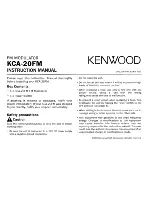
11 / 14
1.13.2 Transport stream ID (TSID) and original network
ID (ONID)
As the data rate of a COFDM-modulated transport stream is normally lower than the data rate of the received transport stream, it
may be necessary to distribute the services of an individual transport stream at the input to several transport streams at the output.
In their search mode some receivers do then not detect all channels that were originally compiled in the original transport stream.
In this case they require the “TSID” transport stream ID to be adjusted and/or “ONID” original network ID.
Note:
The TSID and the ONID are 16-bit numbers. A transport stream can be differentiated from all other transport
streams in a DVB-T system by a unique combination of TSID and ONID. For DVB the ONID normally
describes the original location of a transport streams.
Menus are available for editing the TSID and the ONID. The values can be modi
fi
ed by selecting the corresponding “orig” entry
using the “<” or “>” buttons and set to the “edit” value by using the “+” or “-” buttons. The current values of the TSID and ONID
from the processed transport stream are displayed in hexadecimal notation. In the “edit” setting you can modify the values of
the corresponding IDs. To do this, select the value using the “>” button. Use the “+” or “-” key to change the current value in ± 1
increments. Alternatively you can also select numeric setting mode by pressing the
button. In numeric mode each digit can be
modi
fi
ed by pressing the “+” or “-” keys in ± 1 increments. All IDs should be entered in hexadecimal format. Possible values
are “00h” to “FFh” for the OID and “0000h” to “FFFFh” for the TSID and the ONID.
Note:
Only experienced users should modify the TSID or ONID. If several channels (services) of a SAT transport
stream are distributed to multiple COFDM transport streams, it is possible that the receiver cannot
automatically detect all channels because in this case the uniqueness of the TSID / ONID pair is lost.
In this case please proceed as follows:
• Preferably the ONID should be modi
fi
ed. If possible, set it to a value between FF00h and FFEEh. This range
is reserved for private use and is not used by public network operators.
• If the channel search is unsuccessful despite the ONID adjustment, the TSID can be modi
fi
ed. Please
ensure that all TSIDs in a system are adjusted to guarantee uniqueness for each transport stream.
This sub-menu can be exited only when the cursor is on the “OID” parameter. To do this, use the “<” and “>” buttons to select “OID”
and press the “Sub-menu” button
to return to the main menu.
Note:
Modifying the TSID and the ONID requires that the channel
fi
lter is active.
1.14
Conditional Access with CI retro
fi
t kit
(only if CI retro
fi
t kit
fi
tted)
The
UFZ 394 CI retro
fi
t kit
(200610097) can be
fi
tted to enable decoding of encrypted channels. Fitting is described in the
documentation.
If the UFZ 394 CI retro
fi
t kit is
fi
tted, the software detects this automatically and modi
fi
es the menu contents accordingly.
Main menu
A
1236
MHz
TP
27.500
MS/s
3/4
QPSK
Outp.
S21
306.00
MHz
8
MHz
QAM64
!
“Transport stream processor” sub-menu
***
UFO331TP
***
Filter
on
IDs
CI
The “TP” transport stream processor is selected with the “<” or “>” buttons and the sub-menu is called up with the “Sub-menu”
button
. If the UFZ 394 CI retro
fi
t kit is detected, the “CI” parameter appears.
“CI” is selected using the “<” and ”>” buttons and the sub-menu below is called up using the “Sub-menu” button
.
Содержание UFO 331/TP
Страница 71: ......
















































